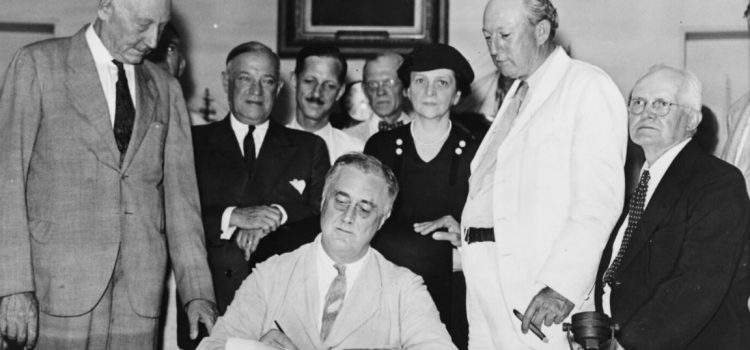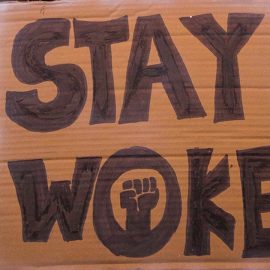

This article is an excerpt from the Shortform book guide to "The Road to Character" by David Brooks. Shortform has the world's best summaries and analyses of books you should be reading.
Like this article? Sign up for a free trial here .
Who was Frances Perkins? In what ways did Perkins assist in making the New Deal?
In his book The Road to Character, David Brooks talks about several historical figures who acted selflessly to benefit the greater good. The first person Brooks outlines is Frances Perkins, the woman behind the New Deal.
Here is a brief overview of Frances Perkins’s biography, as written by David Brooks.
The Life of Frances Perkins
In The Road to Character, Frances Perkins’s biography starts when Perkins was called into service through a life-changing event—at age 31. She walked out of a Manhattan tea party to witness the Triangle Shirtwaist fire, one of the most famous factory fires in American history, in which 146 garment workers perished. Seeing young working women jump to their deaths from the building’s high floors catalyzed Perkins to become a crusader for workers’ rights.
Prior to the Triangle Shirtwaist fire, Perkins lived the way many early-20th-century women with her privileged upbringing did. She was raised in a strict New England Yankee family and graduated from a women’s college, Mount Holyoke, in 1902. Her professors had emphasized the importance of sacrificial service, and Perkins hoped she might be able to do something heroic with her life. But she wasn’t devoted to any specific cause and didn’t have a grasp on her life’s direction.
After college, Perkins floundered for a while, then eventually went to work at Hull House, where affluent women lived with poor and working-class people and served as their counselors and advisers. She then moved to New York City to lobby against child labor at the National Consumers League. But although she seemed to be headed toward a life of service, she remained a bit of a dabbler, doing what she believed were “good works” while still clinging to her upscale social standing.
The horror of the factory fire provided the incentive she needed, filling her with righteous indignation and strengthening her resolve. Her upper-middle-class good deeds morphed into a true calling. When she was appointed executive secretary for New York City’s Committee on Safety, she left behind her genteel progressive politics and got her hands dirty, metaphorically speaking. She worked side-by-side with callous and often unscrupulous labor unionists, particularly members of New York’s Tammany Hall political machine. She was the only woman in a tough, male-dominated world, but these powerful men came to respect her. Perkins advocated for legislation to make factories safer for workers, to cap the maximum number of hours women could work in a week, and to create a minimum wage.
Perkins’s Struggles
Although Perkins’s career was noteworthy, she faced many difficulties in both her personal and professional life. As a young woman, she met and married Paul Wilson, who shared her progressive views. They were happy for a while, but soon after Perkins and Wilson had a child together, Wilson began to show signs of bipolar disorder. He was often prone to inexplicable violent ranges, which frightened Perkins. In one of his manic stages, he made a reckless investment and lost all of the family’s money. Eventually, he was institutionalized, and Perkins had to support him financially. The couple’s daughter inherited his disease, and Perkins also had to caretake and support her, even well into her 70s.
Perkins kept her unhappy private life hidden from public view as she moved through several positions in New York State government, where she worked to enact unemployment insurance laws, end child labor, and improve workplace safety. Although in her later career she helped to create the federal minimum wage, welfare, and other social policies, she didn’t use those benefits for her own family. Instead, she continued working so she could pay for their expenses herself. She was an intensely private person, and she believed that her family problems were for her alone to solve.
With every year spent in public service, Perkins became even more deeply dedicated to her cause, despite the fact that the work was contentious and difficult—she was engaged in constant political battles and frequently criticized by the press. In 1933, President Franklin Roosevelt appointed her Secretary of the Department of Labor, the first woman to hold a cabinet position. She worked with FDR to enact social welfare laws and programs as part of the New Deal. At one point, her political enemies tried to get her impeached. She was exhausted, unhappy, and wanted to quit, but FDR would not grant her request to retire. Out of loyalty to him and to her position, she stayed. She was finally released from his cabinet when Truman took office in 1945. She spent the remainder of her years teaching at Cornell, then died alone in a hospital at age 85.
Lessons From Perkins’s Life
- We all have natural talents and gifts, and we’re all embedded in circumstances that require action. It’s our job to figure out where we can apply our gifts. Instead of asking ourselves what we want from life, we should be asking what life wants from us. A true calling or vocation is not about fulfilling our own desires; it’s about filling the world’s needs.
- A vocation requires total commitment. Perkins endured a tremendous amount of personal hardship and made huge personal sacrifices. But she did not boast about her achievements or complain about her lot in life. In fact, she mostly avoided the pronoun “I.” She was humble enough to believe that she was simply doing a job that needed to be done.

———End of Preview———
Like what you just read? Read the rest of the world's best book summary and analysis of David Brooks's "The Road to Character" at Shortform .
Here's what you'll find in our full The Road to Character summary :
- How the world has become "me-focused" rather than "we"
- An analysis of eight historical figures who selflessly contributed to the greater good
- A 15-point plan to help you live a more virtuous and happy life






